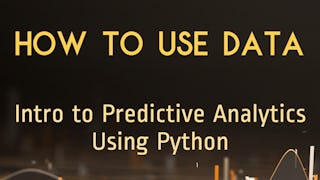This course provides a comprehensive, hands-on introduction to Artificial Intelligence and Predictive Analytics using Python. Learners will progress from foundational concepts of predictive modeling and ensemble methods to advanced unsupervised clustering techniques like Meanshift, Affinity Propagation, and Gaussian Mixture Models. The course then explores supervised learning algorithms, including Logistic Regression, Naive Bayes, and Support Vector Machines, and transitions into logic programming and problem-solving approaches such as heuristic search, local search, and constraint satisfaction problems.


您将学到什么
Apply predictive analytics and ML algorithms to real problems.
Analyze clustering, classification, and NLP pipelines in Python.
Construct AI solutions using logic, rules, and search strategies.
您将获得的技能
- Predictive Modeling
- Data Science
- Unsupervised Learning
- Scikit Learn (Machine Learning Library)
- Applied Machine Learning
- Algorithms
- Computational Logic
- Python Programming
- Supervised Learning
- Predictive Analytics
- Natural Language Processing
- Artificial Intelligence
- Unstructured Data
- Text Mining
- Data Processing
- Random Forest Algorithm
- Machine Learning Algorithms
要了解的详细信息

添加到您的领英档案
September 2025
13 项作业
了解顶级公司的员工如何掌握热门技能

积累特定领域的专业知识
- 向行业专家学习新概念
- 获得对主题或工具的基础理解
- 通过实践项目培养工作相关技能
- 获得可共享的职业证书

该课程共有4个模块
This module introduces learners to the fundamentals of predictive analytics with Python, focusing on essential machine learning methods used in real-world applications. Learners will begin by exploring the core concepts of predictive analysis, then progress into powerful ensemble algorithms such as Random Forest, Extremely Random Forest, and Adaboost, while addressing practical challenges like class imbalance. The module culminates in applying these models to a real-world case study on traffic prediction, ensuring learners gain both conceptual understanding and hands-on predictive modeling experience.
涵盖的内容
7个视频3个作业
This module explores the power of unsupervised learning techniques in Python for discovering hidden patterns in data. Learners will begin with the foundations of clustering methods such as Meanshift and advance into more sophisticated models like Affinity Propagation and Gaussian Mixture Models. The module emphasizes evaluating clustering quality metrics and applying these techniques in practical programming scenarios. By the end of this module, learners will be able to analyze, implement, and evaluate clustering algorithms for real-world applications in domains like customer segmentation, image processing, and pattern recognition.
涵盖的内容
10个视频3个作业
This module introduces learners to the fundamentals of supervised learning in Python and explores the integration of logic-based programming for AI problem-solving. The first part focuses on popular classification methods such as logistic regression, Naive Bayes, and Support Vector Machines (SVM), along with practical tools like the confusion matrix for evaluating predictive performance. The second part transitions into symbolic AI through logic programming, covering applications such as family tree reasoning, puzzle solving, heuristic search, local search techniques, and constraint satisfaction problems (CSPs). By the end of this module, learners will gain the ability to apply classification algorithms, interpret performance metrics, and construct logic-based solutions to real-world AI challenges.
涵盖的内容
20个视频3个作业
This module provides a practical foundation in Natural Language Processing (NLP) using Python and NLTK. Learners will explore the complete NLP pipeline, from tokenization and text preprocessing to stemming, lemmatization, and segmentation. The module further introduces advanced tasks such as information extraction, chunking, chinking, and Named Entity Recognition (NER). Finally, learners will study parsing techniques using Context-Free Grammar (CFG), recursive descent parsing, and shift-reduce parsing to analyze sentence structure. By the end of this module, learners will be able to apply NLP techniques in Python for text analysis, information extraction, and grammar-based parsing of natural language.
涵盖的内容
22个视频4个作业
获得职业证书
将此证书添加到您的 LinkedIn 个人资料、简历或履历中。在社交媒体和绩效考核中分享。
从 Machine Learning 浏览更多内容
 状态:免费试用
状态:免费试用University of Pennsylvania
 状态:免费试用
状态:免费试用
人们为什么选择 Coursera 来帮助自己实现职业发展




常见问题
To access the course materials, assignments and to earn a Certificate, you will need to purchase the Certificate experience when you enroll in a course. You can try a Free Trial instead, or apply for Financial Aid. The course may offer 'Full Course, No Certificate' instead. This option lets you see all course materials, submit required assessments, and get a final grade. This also means that you will not be able to purchase a Certificate experience.
When you enroll in the course, you get access to all of the courses in the Specialization, and you earn a certificate when you complete the work. Your electronic Certificate will be added to your Accomplishments page - from there, you can print your Certificate or add it to your LinkedIn profile.
Yes. In select learning programs, you can apply for financial aid or a scholarship if you can’t afford the enrollment fee. If fin aid or scholarship is available for your learning program selection, you’ll find a link to apply on the description page.
更多问题
提供助学金,






